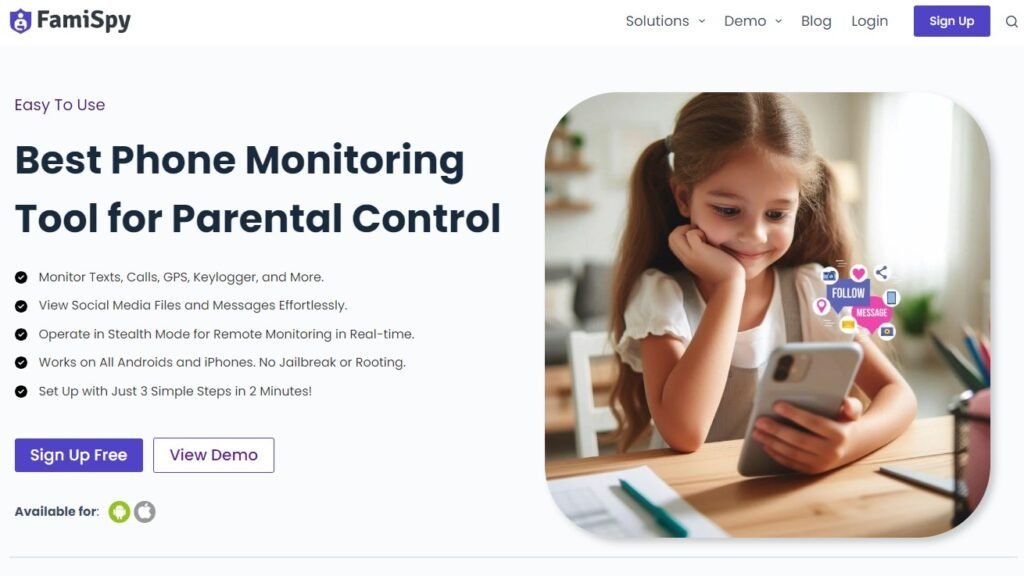If your child uses Snapchat, the biggest danger isn’t what they post — it’s what disappears before you ever see it. This is exactly why so many parents worry and wonder: Is Snapchat safe for kids today?
The honest answer is that the app is both engaging and inherently risky, primarily because its core design makes messages and Snaps vanish before you can verify them. This “consequence-free” feeling often leads to serious risks, including sharing inappropriate content and dangerous contact with strangers. While the platform offers basic privacy settings, they are insufficient. To make Snapchat truly safe, parents must adopt a proactive monitoring strategy.
Don’t Just Worry: Does Your Child’s Content Vanish Before You See It?
🛡️ FamiSpy provides full Snapchat visibility, capturing every message, snap, and keystroke. Take action now to protect your child from hidden digital dangers.
VIEW DEMOSnapchat’s Age Rule: How Old Do You Have To Be?
A crucial starting point for parents is understanding how old you have to be for Snapchat.
Minimum Age Requirement (13+)
The platform’s Terms of Service state that the minimum age is 13. This is the legal requirement, based on digital maturity guidelines. If your child is under 13, their account should technically be deleted. However, as many parents know, children can easily circumvent this rule by entering a false birth date.
Why 12-Year-Olds Are at Highest Risk
The question of whether Snapchat is safe for 12-year-olds (or younger) highlights a valid parental concern. Younger children often lack the maturity to handle disappearing content, complex privacy settings, and the pressure of maintaining “Snap Streaks” (a streak of daily Snaps exchanged with a friend).
Where Snapchat’s Family Center Fails Parents
Snapchat has introduced the Family Center, which allows parents to see who their teens are friends with. This system explicitly does not allow parents to view the content of messages or Snaps, leaving a significant blind spot in safety assurance.
Top Risks: Why Is Snapchat Bad for Kids?
The risks outlined below explain exactly why many parents conclude that Snapchat is bad for kids. Understanding these inherent dangers is the first step toward effective mitigation.
1. The False Security of “Disappearing” Snaps
The core feature of vanishing messages is the biggest safety flaw. Snapchat gives children the false belief that what they send is temporary. This encourages casual and high-risk sharing. As parents, our biggest fear is that children share content we can never verify, leaving us blind to the risks.
- Saving Content: Content is easily saved. A recipient can quickly take a screenshot, use a second device to take a photo, or use screen-recording software.
- The Permanent Record: Parents need to teach their children that nothing sent online truly disappears. If an image is saved, it can be shared, edited, and uploaded anywhere, making Snapchat a high-risk platform for sending private photos.
2. Snap Map: The Real-Time Location Danger
Snap Map is a feature that shows a user’s real-time location to their friends. While fun for close friends, it poses a serious danger when a child accepts a stranger’s friend request. If you find your child has their location enabled on Snap Map, be highly cautious and disable it immediately.
- Real-Time Tracking: A child’s location can be pinpointed to a specific address, making them vulnerable to real-world encounters.
- The Solution: All parents must ensure their child’s Snap Map is set to “Ghost Mode” immediately.
3. Snapchat AI (My AI) and Data Privacy
A key area of inquiry for guardians is establishing whether Snapchat My AI is safe for kids. Unfortunately, Snapchat does not allow full removal for most users, making proactive monitoring crucial. The platform’s integrated AI chatbot is a risk factor from two main perspectives:
- Strangification (Algorithm Recommendation): The AI can suggest friends or content based on chat history, potentially guiding children toward risky contacts or themes.
- Data Retention: While seemingly private, all interactions with My AI are stored by Snapchat, raising concerns about data privacy and the content being logged.
4. Inappropriate Content on the Discover Feed
Parental worry often centers on the content, specifically, why is Snapchat Discover so inappropriate? The Discover feed and Spotlight (TikTok-like video feed) often push viral, unfiltered, and adult-oriented content, including suggestive images, celebrity gossip, and mature themes.
- Exposure: This content is readily available to underage users and can expose them to mature language, sexual themes, and unhealthy body image pressures they are not ready for.
5. Direct Contact from Strangers
Snapchat’s settings default can make it too easy for strangers to contact your child. These unsolicited messages, often known as “cold contacts,” can lead to grooming, cyberbullying, and other dangerous interactions. A common case type involves strangers contacting a 10-year-old through Quick Add and attempting to switch the conversation to platforms that offer stronger encryption.
6. Addiction and Mental Health Stress
The pressure to maintain Snap Streaks can lead to significant stress and anxiety, causing children to feel compelled to check the app constantly. Furthermore, the curated nature of social media can negatively affect self-esteem.
Essential Snapchat Safety Tips: Parental Action
Making Snapchat safe requires proactive steps, not just hoping for the best. Follow these Snapchat safety tips immediately.
Step 1: Secure Privacy Settings
You must physically check your child’s phone and adjust these crucial settings:
| Setting | Path / Location | Action | Why? |
|---|---|---|---|
| 💬 Who Can Contact Me | Settings → Privacy Controls → Contact Me | Set to “My Friends” | Stops strangers from messaging directly. |
| 👁️ Who Can View My Story | Settings → Privacy Controls → View My Story | Set to “My Friends” | Prevents public sharing of daily activities. |
| 📍 Snap Map | Settings → See My Location | Set to “Ghost Mode” | Hides the child’s location completely. |
| ➕ Quick Add | Settings → Privacy Controls → Quick Add | Turn OFF | Prevents your child from appearing as a suggestion to strangers. |
Step 2: Open Communication
Talk to your child about the reality of the platform. Focus on building trust:
- “The Screenshot Rule”: Explain that a screenshot lasts forever. If they wouldn’t print it and hang it on the fridge, they shouldn’t send it.
- Strangers are Strangers: Explain that someone on Snapchat with a cartoon avatar is still a stranger, and their profile information may be fake.
FamiSpy: Advanced Snapchat Parent Controls
While the official Snapchat parent controls are a decent start, they are severely limited because they do not allow you to view the actual messages and Snaps—the highest-risk activity. For parents who need a comprehensive safety net, a professional monitoring tool like FamiSpy is necessary.

FamiSpy is designed to solve the exact problems that make Snapchat dangerous for kids and provides an all-encompassing safety solution. Why are official tools not enough? See the comparison:
| Feature | Snapchat Family Center | FamiSpy |
|---|---|---|
| 💬 View Messages / Snaps Content | ❌ | ✅ |
| 🔡 View Keystrokes (Keylogger) | ❌ | ✅ |
| 📍 Track Location | Limited (Snap Map only) | Full GPS history |
| 📊 View App Daily Usage Report | ❌ | ✅ |
| 📞 Monitor Calls & Texts | ❌ | ✅ |
FamiSpy’s Snapchat Message Viewer captures all sent and received messages and Snaps. Combined with Keystroke Recording and Remote Screen Capture, it ensures that evidence of risky behavior never disappears, giving parents peace of mind even when content is designed to vanish.
The application also provides a precise location tracker (independent of Snap Map) and an App Daily Usage Report, allowing parents to monitor their child’s movements and manage screen time effectively. This helps reduce screen addiction and keeps children safer in the real world.
Beyond Snapchat, FamiSpy offers full device visibility. By monitoring calls, texts, and stored photos/videos, parents can quickly identify and block dangerous contacts trying to reach their child through any channel, ensuring comprehensive digital safety.
Frequently Asked Questions (FAQ)
Conclusion: Should Kids Have Snapchat?
Ultimately, the decision of whether kids should have Snapchat is personal, but safety is non-negotiable. Snapchat is inherently designed for high-speed, casual sharing, which creates a complex environment for young users. For parents committed to providing maximum protection and visibility into the platform’s risky “disappearing” content, relying solely on basic privacy settings is insufficient. Tools like FamiSpy close the critical monitoring gap, allowing you to provide a digital safety net that keeps pace with the app’s potential dangers.
Don’t Miss:








